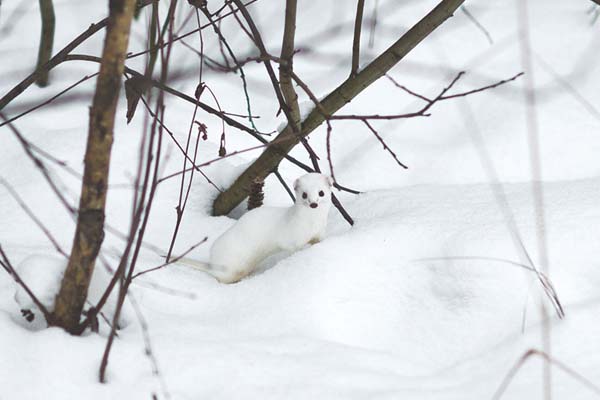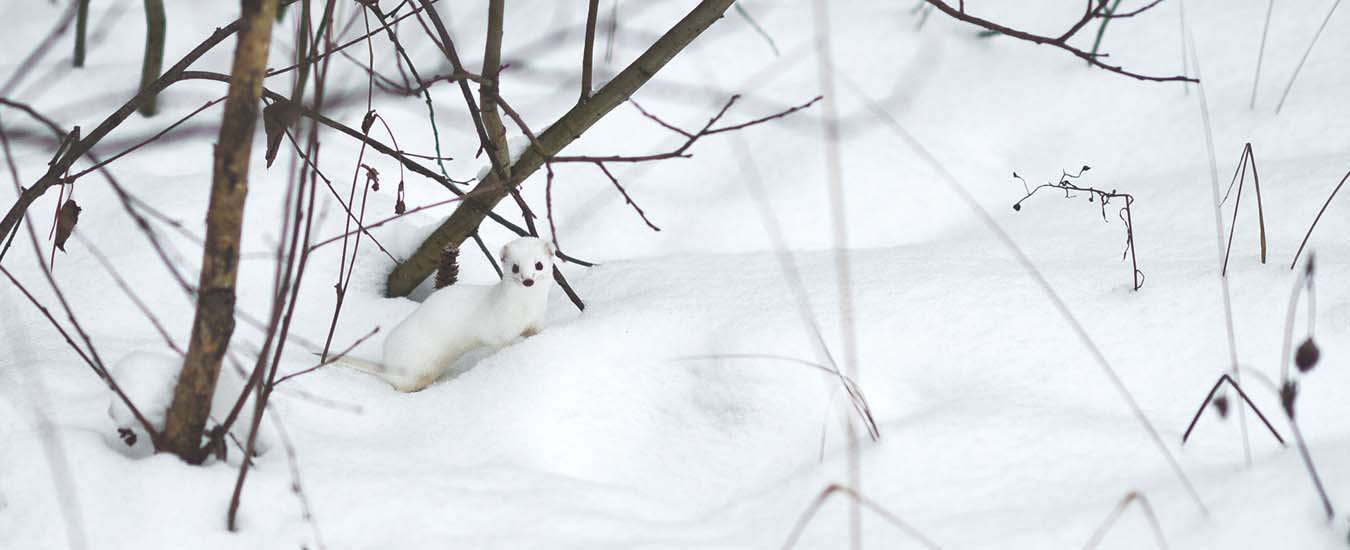Bold, pint-sized hunters
Many moons ago I found myself in deep balsam fir woods studying the population dynamics of an insect to determine how it dispersed throughout the forests north of Fredericton, NB. Usually my pack lay on the forest floor while I adjusted weather instruments on staging that rose up 60 feet to the tree tops.
One day a small brown animal as thick as a mouse and measuring about a foot (30 cm) long from nose to tip-of-tail quickly ran to the pack and disappeared. Moments later it emerged and bounded towards me. I stood still as it scampered up a pant leg, and paused at my waist before launching itself up my shirt. I brushed it off when it reached my face. This fearless beast, a male weighing about three ounces (85 grams), is a voracious hunter known as an ermine, stoat, or short-tailed weasel. Females are roughly half the size.
In western New Brunswick one other weasel species prowls the land: the slightly larger, long-tailed weasel. Males usually measure about 18 inches (45 cm) long and weigh 225 grams. Females are about 25 per cent smaller and weigh about 102 grams. Short and long-tailed weasels belong to the same Mustelid family along with mink, otters, badgers, martins and skunks.
Brown on top and yellowish-white below during warmer months, the weasel’s coat sheds to a winter white, except for its tail tip that remains coal black year-round. The fur trade calls their winter pelts “ermine”, a luxuriant white fur that lined the cloaks and sleeves of European aristocracy in medieval times.
Besides climbing legs and trees, weasels swim streams and hunt during any of the 24 hours in a day. Their preferred menu is mice or voles, but they will consume almost anything alive, from earthworms to ducks and grouse. How, you say, can such a small animal eat a grouse? Well, that’s not exactly what they do. Weasels climb trees at night while the birds are asleep, roosting with their feet clamped on to a tree limb while they slumber. The weasel gently bites open the jugular vein in the sleeping bird’s neck with needle-like canine teeth. The little vampire quietly laps up blood that the bird’s heart pumps out until death occurs.

Photo by: Brittany Crossman
Weasels stand on hind legs to search for prey, and are often prompted by a keen sense of smell. They typically bound into action, chasing a retreating rodent into its hiding places underground. I’ve watched a weasel enter red squirrel holes that riddled the ground under a softwood forest. In one hole, out another. Repeat: “Pop” goes the weasel, as squirrels launch from their hiding places to avoid being cornered. A kill is administered as a quick, effective bite to the back of the neck or the base of the skull.
Weasels are very efficient predators. Being thin enough to chase mice in their tunnels means that weasels possess little fur or insulating fat, and their wiener shape has a high surface-to-volume ratio. To put it another way, having slim, go-anywhere bodies becomes a heat-losing liability in cold weather. The frenetic metabolism, fueled by a heart that beats several hundred times a minute, consumes enormous amounts of energy, forcing them to consume two or three mice or voles a day. That’s equivalent to half the weasel’s own weight. Weasel metabolism is double that of other, similar-sized animals.
These winter challenges are overcome in several ways. Camouflage gives weasels an element of surprise. Scientists have shown that the black tipped tail tends to distract predators like owls and hawks away from the creature’s body. Males roam more widely than females. When they enter the attached pit greenhouse in the front of our south-facing home, we can hear the mice squeaking in terror.
Weasels often take over the burrows of mice, squirrels and chipmunks. They use fur, feathers, dry grasses and leaves to insulate their nests. Some will build dens in hollow logs, under tree roots, and buildings.

Often referred to as ermine while sporting the white pelt of winter, weasels are efficient predators with high metabolisms.
Bigstock/ Alenazamotaeva
Starvation is a leading cause of death for short-tailed weasels. They continue to hunt in winter even after they have made ample kills, stockpiling carcasses in the burrow for leaner times. When they have an ample food cache in winter, and are not hunting, they rest in their comfy, snow-covered burrow, usually keeping themselves warm by sleeping in a ball to minimize heat loss, and maintaining themselves by slow, steady eating.
Summers bring an abundance of food. That’s when males leave their home territories to find females and mate. Females have an ability to stop the pregnancy clock, so to speak. They can keep their fertilized eggs dormant for 10 months. When next spring arrives with plenty to eat, the eggs begin growing again, culminating when young are born in April or May.
With lifetimes lasting up to seven years, but averaging only 18 months, weasels waste little time when it comes to reproduction. Females become fertile when they reach the age of six weeks. That’s when adult males enter the nest to breed with them, sometimes even before their eyes are open. Adult females breed again while still nursing their young. By autumn the young weasels are independent, with all females usually pregnant.
One summer on a remote farm, a family of weasels, composed of mom and six youngsters, waited every Friday morning for me to deliver garbage for pickup at the end of a long driveway. Excited and anxious at my arrival, they could hardly wait to plunder the bag I delivered roadside.
Weasels have three basic vocalizations—a trill, a screech and a squeal. I heard the trill when the mother was communicating to her offspring, and when the siblings were vocalizing with each other. A screech is used to startle prey or predators, and with prey it is followed by an attack. When they experience pain or distress, weasels squeal like many other mammals.

Scientists have shown that the weasel’s black-tipped tail tends to distract predators like owls and hawks away from its body.
Photo by: Brittany Crossman
“Weasel words” and “weaseling out” are derogatory terms alluding to an infamy that may be the result of rare killing sprees in barns; sprees that litter the floor with dead chickens and infuriate farmers. It’s an unfair slander of an interesting animal. One study in North Carolina found that most deaths attributed to weasels were actually committed by rats. If a pen or cage is porous enough to let in mice, it will admit weasels as well and thus needs more reinforcement.
One researcher, a professor of wildlife ecology at the University of Agricultural Sciences in Umea, Sweden, kept a weasel in a cage temporarily, feeding it live mice which it promptly killed and ate; except for one. “Curiously,” he says, “the weasel and one mouse became like friends.” This liaison persisted for some time while the weasel continued to kill and eat other mice. Eventually the weasel was released back into the wild, leaving the healthy mouse.
In Cape Breton a friend once rescued an injured weasel and helped it recover. Sue and the weasel became devoted pals. Like most creatures, weasels have a good side.
